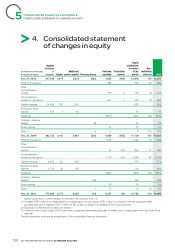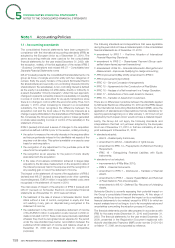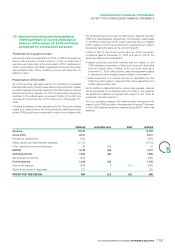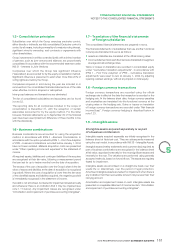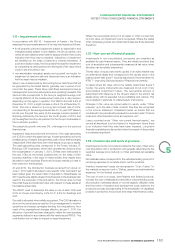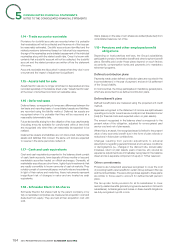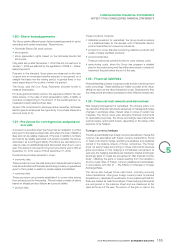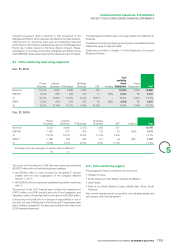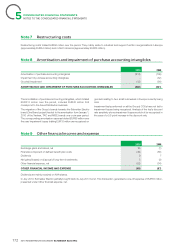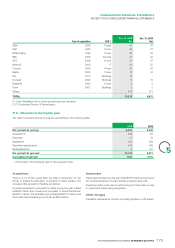APC 2010 Annual Report Download - page 168
Download and view the complete annual report
Please find page 168 of the 2010 APC annual report below. You can navigate through the pages in the report by either clicking on the pages listed below, or by using the keyword search tool below to find specific information within the annual report.
CONSOLIDATED FINANCIAL STATEMENTS
5NOTES TO THE CONSOLIDATED FINANCIAL STATEMENTS
hedging instrument that is determined to be an effective hedge is
accumulated in equity, under “Other reserves”, and recognised in
the statement of income when the hedged item affects profi t or loss.
The ineffective portion of the gain or loss on the hedging instrument
is recognised in “Net fi nancial income/(loss)”.
In addition, certain long-term receivables and loans to subsidiaries
are considered to be part of the net investment, as defi ned by IAS21
– The Effects of Changes in Foreign Exchange Rates. In accordance
with the rules governing hedges of net investments, the impact of
exchange rate fl uctuations is recorded in equity and recognised in
the statement of income when the investment is sold.
Interest rate swaps
Interest rate swaps allow the Group to manage its exposure to
interest rate risk. The derivative instruments used are fi nancially
adjusted to the schedules, rates and currencies of the borrowings
they cover. They involve the exchange of fi xed and fl oating-rate
interest payments. The differential to be paid (or received) is accrued
(or deferred) as an adjustment to interest income or expense over
the life of the agreement. The Group applies hedge accounting as
described in IAS39 for interest rate swaps. Gains and losses on re-
measurement of interest rate swaps at fair value are recognised in
equity (for cash fl ow hedges) or in profi t or loss (for fair value hedges).
Commodity contracts
The Group also purchases commodity derivatives including forward
purchase contracts, swaps and options to hedge price risks on all or
part of its forecast future purchases. Under IAS39, these qualify as
cash fl ow hedges. These instruments are recognised in the balance
sheet and are measured at fair value at the period-end. The effective
portion of the hedge is recognised separately in equity (under “Other
reserves”) and then recognised in income (gross margin) when the
hedged item affects consolidated income. The effect of this hedging
is then incorporated in the cost price of the products sold. The
ineffective portion of the gain or loss on the hedging instrument is
recognised in “Net fi nancial income/(loss)”.
Cash flows from financial instruments are recognised in the
consolidated statement of cash fl ows in a manner consistent with
the underlying transactions.
Put options granted to minority shareholders
In line with the AMF’s recommendation of November2010 and in
the absence of a specifi c IFRS rule, the Group elected to retain
the accounting treatment for minority put options applied up to
December31, 2009 (involving puts granted to minority shareholders
prior to this date). In this case, the Group elected to recognise the
difference between the purchase price of the minority interests
and the share of the net assets acquired as goodwill, without re-
measuring the assets and liabilities acquired. Subsequent changes
in the fair value of the liability are recognised by adjusting goodwill.
In the absence of any new put options granted to minority
shareholders since January1, 2010, the Group hasn’t had to decide
on an accounting treatment for them.
1.24 - Revenue recognition
The Group’s revenues primarily include merchandise sales and
revenues from services and contracts.
Merchandise sales
Revenue from sales is recognised when the product is shipped and
risks and benefi ts are transferred (standard shipping terms are FOB).
Provisions for the discounts offered to distributors are set aside
when the products are sold to the distributor and recognised as a
deduction from revenue.
Certain Group subsidiaries also offer cash discounts to distributors.
These discounts and rebates are deducted from sales.
Consolidated revenue is presented net of these discounts and
rebates.
Service contracts
Revenue from service contracts is recorded over the contractual
period of service. It is recognised when the result of the transaction
can be reliably determined, by the percentage of completion method.
Long-term contracts
Income from long-term contracts is recognised using the percentage-
of-completion method, based either on the percentage of costs
incurred in relation to total estimated costs of the entire contract, or
on the contract’s technical milestones, notably proof of installation
or delivery of equipment. When a contract includes performance
clauses in the Group’s favor, the related revenue is recognised at
each project milestone and a provision is set aside if targets are
not met.
Losses at completion for a given contract are provided for in full
as soon as they become probable. The cost of work-in-process
includes direct and indirect costs relating to the contracts.
1.25 - Earnings per share
Earnings per share are calculated in accordance with IAS33 –
Earnings Per Share.
Diluted earnings per share are calculated by adjusting profit
attributable to equity holders of the parent and the weighted average
number of shares outstanding for the dilutive effect of the exercise
of stock options outstanding at the balance sheet date. The dilutive
effect of stock options is determined by applying the “treasury stock”
method, which consists of taking into account the number of shares
that could be purchased, based on the average share price for the
year, using the proceeds from the exercise of the rights attached to
the options.
1.26 - Statement ofcashflows
The consolidated statement of cash flows has been prepared
using the indirect method, which consists of reconciling net profi t
to net cash provided by operations. The opening and closing
cash positions include cash and cash equivalents, comprised of
marketable securities, (note1.17) net of bank overdrafts and facilities.
2010 REGISTRATION DOCUMENT SCHNEIDER ELECTRIC166


